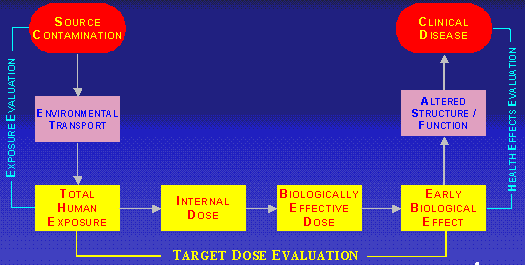Slide 1
Agency for Toxic Substances
and Disease Registry- Susan W. Metcalf, MD, MSPH
|
Slide 2
Exposure Investigation
Spring Valley Chemical Munitions
Washington, DC- Ketna Mistry, M.D., F.A.A.P
- Ken Orloff, Ph.D., DABT
|
Slide 3
ATSDR
The primary public health agency for addressing human health issues that might arise from exposure to hazardous substances |
Slide 4
Continuum for Relating Environmental Contamination
with Clinical Disease
 |
Slide 5
Purpose of an Exposure Investigation
To better characterize past, current, and possible future human exposures to hazardous substances in the environment. |
Slide 6
Exposure Investigation: Data Gathering
- Environmental samples
- Biomarkers
- Exposure-dose reconstruction
|
Slide 7
Arsenic Biomarkers: Blood
- Quantifies the absorbed Arsenic
- Clears within a few hours
- Not useful for low-level exposure
|
slide 8
Arsenic Biomarkers: Urine
- Good marker of recent exposure
- Includes both inorganic and organic forms
- Reference range available
|
slide 9
Total Arsenic in Urine
- Inorganic As (As+3, As+5)
- MMA (monomethylarsonic acid)
- DMA (dimethylarsenic acid)
- Trimethylated forms
- Arsenobetaine
- Arsenocholine
|
slide 10
Arsenic Biomarkers: Hair
- Measures several months of exposure
- Collection is non-invasive
|
slide 11
Limitations of Hair as Biomarker
- Possibility of external contamination
- Paucity of reference range data for unexposed populations
|
slide 12
Playground Arsenic Levels
- Soil arsenic levels
- Average 57 ppm
- Highest level 498 ppm
- Children immediately relocated to another area of the campus
|
slide 13
Playground Characteristics
- Covered with 2 inches of mulch or grass in some areas
- Playground is periodically remulched
|
slide 14
Target Population
- Daycare roster:
- Length of time at daycare:
- ~50% present: < 7 months
- ~50% present: > 1 year
|
slide 15
Other Sources of Arsenic
- Wood preservatives
- Pesticides
- Arsenic containing herbal medicines
- Parental occupational exposure
- Hobbies
- Consumption of seafood
- Pica (soil eating) behavior
|
slide 16
Results
- Hair samples for arsenic:
- 24/ 32 hair samples : not detected
- 8 / 32 hair samples: detected
- 8 Arsenic detected hair samples ranged from 0.10 ppm to 0.14 ppm
|
slide 17
Background Hair Arsenic Levels
- Textbooks: < 1 ppm
- National Research Council: 0.2 ppm
- NCEH: 95th percentile: 0.28 ppm
|
slide 18
Conclusion
- Hair arsenic levels were not elevated in the 32 participants of this exposure investigation
- Therefore, no unusual exposure to arsenic was found in the participants at the Child Daycare Center
|
slide 19
Speciated Urine Arsenic (µg/L)(Kalman, 1990)
Age Group
(boys) | Rushton | Control | | 0-6 years | 65 | 11 | | 7-13 years | 30 | 13 | | 14-20 years | 10 | 9 | | Mean As soil conc | 353 ppm | 7-57 ppm |
|
slide 20
Hwang 1997
- Measured speciated urinary As in 300 children near smelter site
- Average soil levels 121-236 ppm
- Average urinary arsenic levels 8.6 µg/L
|
slide 21
Panther Creek, 1998
- Mining site
- Soil levels up to 3500 ppm
- Urine samples tested for As
- 20/23 below detection levels
- 6-8 µg/g Cr As in samples where As detected
|
slide 22
Panther Creek, ID
- Hair analysis
- 26/36 below level of detection
- 7 had elevated hair levels
- Urine levels not elevated
- All were remediation workers
- Likely due to external contamination
|
slide 23
Past studies of exposure to Arsenic in soil
- At soil levels < 100 ppm, average urine arsenic is similar to background levels
- At soil levels > 100 ppm, urinary levels may show exposure but are below levels associated with health effects
|




 ShareCompartir
ShareCompartir